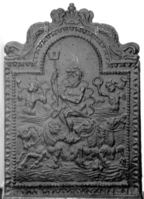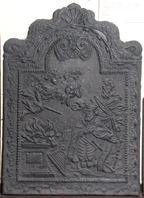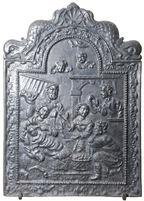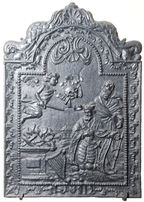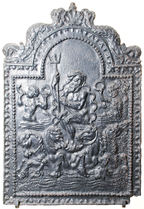-
110
Description: Arched rectangular shaped central panel with fillet and bead edging, Neptune/Poseidon, holding a trident in his right hand, sitting in a scallop shell drawn by four mythical sea horses, behind are two mermaids; arched rectangular shaped border with ovolo egg and dart edging; above, two symmetrical dolphins with a clam shell between.
Notes: Typical type of firebacks produced in Germany for the Dutch market; the central panel was made separately for insertion into different borders; this border is a relatively simple type. Formerly part of the Ade Collection (from Grove Hill, Hellingly, Sussex).
Copies of this fireback are known.
- Decoration tags:
- 'Dutch' (shape)
- ovolo, egg and dart (edging)
- carved pattern panels
- mythological
- animals
- humans
Manufactured: in the mid- to late-17th century possibly in the Siegerland area of Germany.
Current location: Hastings Museum and Art Gallery, John's Place, Bohemia Road, Hastings, East Sussex, England.
Museum number: HASMG: 1952.51.36 (part of the Hastings Museum museum group)
Citation: Lloyd, N., 1925, 'Domestic Ironwork I', Architectural Review, 58, pp. 58-67.
- Attached to series:
- 'Dutch' Miscellaneous Firebacks
- 'Dutch' Dolphin series
-
424
Description: Arched rectangular central panel with bead edging terminating at the top in two loops, gather drapery and a scallop shell; two figures to the right, both bearded, the one kneeling wears cavalry armour, a cloak and a crown, the other stands behind; to the left is a sacrificial pyre on which an ox carcass burns, and above an angel carrying a sword in his right hand and a skull in his left; around this is an arched rectangular border with fillet edging and a repeated leaf pattern; on top is a scallop shell between two dolphins.
Notes: The scene illustrates the visitation of the pestilence on Israel described in 2 Samuel 24, and the sacrifice of an oxen by King David; the skull borne by the angel represents the death of those struck down by the plague. A slightly different version has the face of David looking down (no. 527). Formerly part of the J. H. Every collection.
Copies of this fireback are known.
Manufactured: in the mid- to late-17th century in the Siegerland area of Germany.
Current location: Anne of Cleves House, Southover High Street, Lewes, East Sussex, England.
Museum number: 1944.24.070 (part of the Sussex Archaeological Society museum group)
Citation: Hughes, G. B., 1960, Collecting Antiques (London, Country Life), pp. 85-93.
-
571
Description: Arched rectangular shaped central panel with bead-on-fillet edging; pictorial scene of the interior of the stable at Bethlehem with a stone arched doorway and a hay stall in the background; in the left foreground the seated figure of the Virgin Mary with the infant Jesus, and Joseph behind; behind Joseph a donkey, and to the left of the child a seated ox; to the right, three figures, one kneeling and another holding a hat; in front of the kneeling figure a basket; arched rectangular border with fillet edging and a repeated leaf pattern; on top, a scallop shell between two dolphins.
Notes: The scene is of the Adoration by the Magi - Matthew 2: 11. Mitford collection, Petworth House.
Copies of this fireback are known.
Manufactured: in the mid- to late-17th century in the Siegerland area of Germany.
Current location: Petworth House, Petworth, West Sussex, England.
Museum number: NT/PET/M/62 (part of the National Trust museum group)
- Attached to series:
- 'Dutch' Miscellaneous Firebacks
- New Testament firebacks
- 'Dutch' Dolphin series
-
527
Description: Arched rectangular central panel with bead edging terminating at the top in two loops, gather drapery and a scallop shell; two figures to the right, both bearded, the one kneeling wears cavalry armour, a cloak and a crown, the other stands behind; to the left is a sacrificial pyre on which an ox carcass burns, and above an angel carrying a sword in his right hand and a skull in his left; around this is an arched rectangular border with fillet edging and a repeated leaf pattern; on top is a scallop shell between two dolphins.
Notes: The scene illustrates the visitation of the pestilence on Israel described in 2 Samuel 24, and the sacrifice of an oxen by King David; the skull borne by the angel represents the death of those struck down by the plague. A slightly different version has the face of David looking up at the angel (no. 424). Mitford collection, Petworth House.
Copies of this fireback are known.
Manufactured: in the mid- to late-17th century in the Siegerland area of Germany.
Current location: Petworth House, Petworth, West Sussex, England.
Museum number: NT/PET/M/81 (part of the National Trust museum group)
-
536
Description: Arched rectangular shaped central panel with fillet and bead edging, Neptune/Poseidon, holding a trident in his right hand, sitting in a scallop shell drawn by four mythical sea horses, behind are two mermaids blowing horns; arched rectangular shaped border with ovolo egg and dart edging; above, two symmetrical dolphins with a clam shell between.
Notes: Typical type of fireback produced in Germany by Dutch pattern makers; the central panel was made separately for insertion into different borders; this border is a relatively simple type. Mitford collection, Petworth House.
Copies of this fireback are known.
- Decoration tags:
- 'Dutch' (shape)
- ovolo, egg and dart (edging)
- whole carved pattern
- pictorial
- biblical
- animals
- humans
Manufactured: in the mid- to late-17th century in the Siegerland area of Germany.
Current location: Petworth House, Petworth, West Sussex, England.
Museum number: NT/PET/M/90 (part of the National Trust museum group)
- Attached to series:
- 'Dutch' Miscellaneous Firebacks
- 'Dutch' Dolphin series
